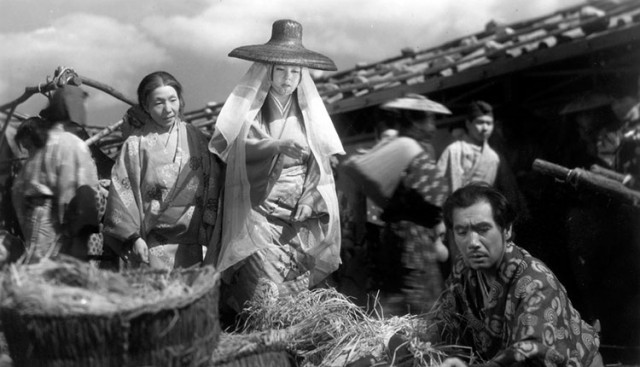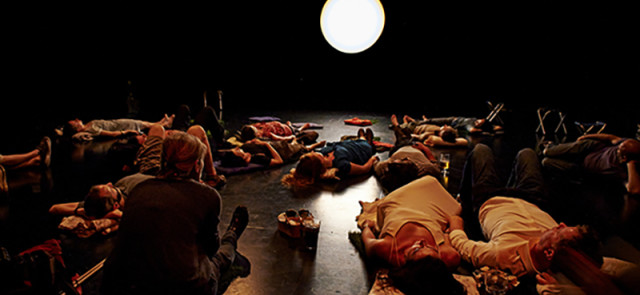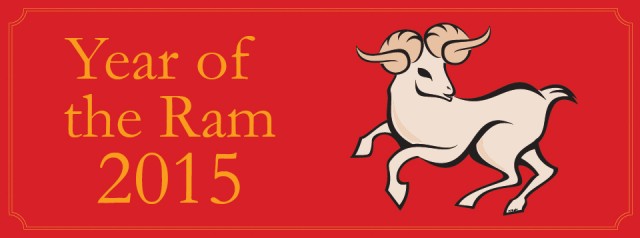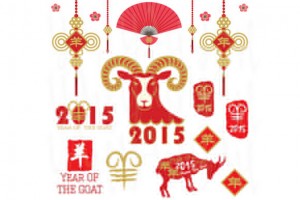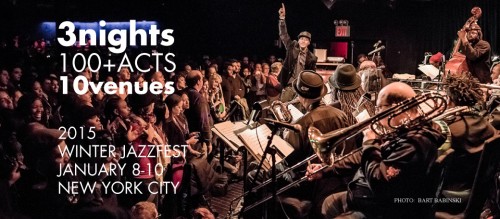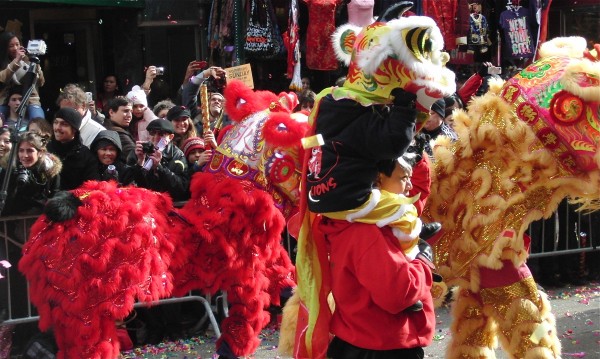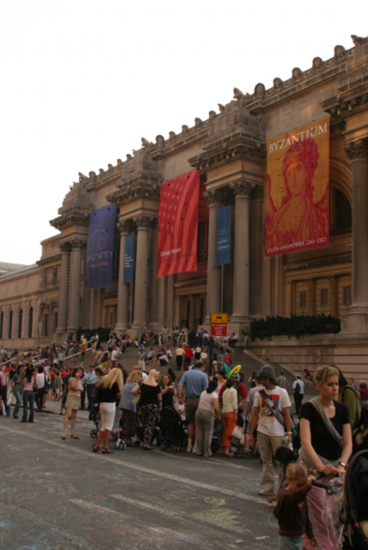
Crowds take to the streets for annual Museum Mile Festival, beginning at the Met
Multiple locations on Fifth Ave. between 82nd & 105th Sts.
Tuesday, June 14, 6:00 – 9:00 pm
Admission: free
www.museummilefestival.org
The Metropolitan Museum of Art, now known as the Met Fifth Avenue with the addition of the Met Breuer in the old Whitney space, is the host of the thirty-ninth annual Museum Mile Festival, in which seven arts institutions along Fifth Avenue between 82nd and 105th Sts. open their doors for free between 6:00 and 9:00. (Met prez Daniel H. Weiss will deliver his opening remarks at 5:45.) There will be live outdoor performances by Dusan Tynek Dance Theatre, DJ Mickey Perez, Sammie & Trudie’s Imagination Playhouse, Mariachi Flor de Toloache, Silly Billy the Very Funny Clown, Miss 360, Alsarah and the Nubatones, Magic Brian, Kim David Smith, and Justin Weber Yo Yo in addition to face painting, art workshops, chalk drawing, and more. The participating museums (with at least one of their current shows listed here) are El Museo del Barrio (“Antonio Lopez: Future Funk Fashion”), the Museum of the City of New York (“Roz Chast: Cartoon Memoirs”), the Jewish Museum (“Isaac Mizrahi: An Unruly History,” “The Television Project: Some of My Best Friends”), the Cooper-Hewitt, National Design Museum (“Beauty — Cooper Hewitt Design Triennial,” “Pixar: The Story of Design”), the Guggenheim (“Moholy-Nagy: Future Present”), the Neue Galerie (“Munch and Expressionism”), and the Metropolitan Museum of Art (“Manus x Machina: Fashion in an Age of Technology,” “Court and Cosmos: The Great Age of the Seljuqs”), along with presentations by the New York Academy of Medicine, the 92nd St. Y, and Asia Society. Don’t try to do too much, because it can get rather crowded; just pick one or two exhibitions in one or two museums and enjoy.
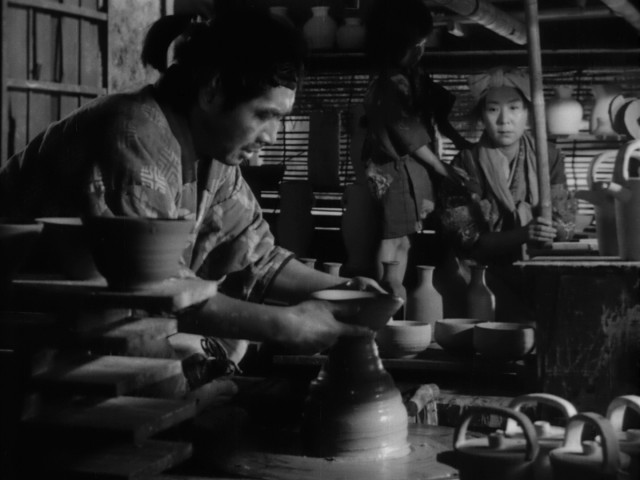
 Asia Society’s “Of Ghosts, Samurai, and War: A Series of Classic Japanese Film” series heads into its second weekend with one of the most important and influential — and greatest — works to ever come from Japan. Winner of the Silver Lion for Best Director at the 1953 Venice Film Festival, Kenji Mizoguchi’s seventy-eighth film, Ugetsu, is a dazzling masterpiece steeped in Japanese storytelling tradition, especially ghost lore. Based on two tales by Ueda Akinari and Guy de Maupassant’s “How He Got the Legion of Honor,” Ugetsu unfolds like a scroll painting beginning with the credits, which run over artworks of nature scenes while Fumio Hayasaka’s urgent score starts setting the mood, and continues into the first three shots, pans of the vast countryside leading to Genjurō (Masayuki Mori) loading his cart to sell his pottery in nearby Nagahama, helped by his wife, Miyagi (Kinuyo Tanaka), clutching their small child, Genichi (Ikio Sawamura). Miyagi’s assistant, Tōbei (Sakae Ozawa), insists on coming along, despite the protestations of his nagging wife, Ohama (Mitsuko Mito), as he is determined to become a samurai even though he is more of a hapless fool. “I need to sell all this before the fighting starts,” Genjurō tells Miyagi, referring to a civil war that is making its way through the land. Tōbei adds, “I swear by the god of war: I’m tired of being poor.” After unexpected success with his wares, Genjurō furiously makes more pottery to sell at another market even as the soldiers are approaching and the rest of the villagers run for their lives. At the second market, an elegant woman, Lady Wakasa (Machiko Kyō), and her nurse, Ukon (Kikue Mōri), ask him to bring a large amount of his merchandise to their mansion. Once he gets there, Lady Wakasa seduces him, and soon Genjurō, Miyagi, Genichi, Tōbei, and Ohama are facing very different fates.
Asia Society’s “Of Ghosts, Samurai, and War: A Series of Classic Japanese Film” series heads into its second weekend with one of the most important and influential — and greatest — works to ever come from Japan. Winner of the Silver Lion for Best Director at the 1953 Venice Film Festival, Kenji Mizoguchi’s seventy-eighth film, Ugetsu, is a dazzling masterpiece steeped in Japanese storytelling tradition, especially ghost lore. Based on two tales by Ueda Akinari and Guy de Maupassant’s “How He Got the Legion of Honor,” Ugetsu unfolds like a scroll painting beginning with the credits, which run over artworks of nature scenes while Fumio Hayasaka’s urgent score starts setting the mood, and continues into the first three shots, pans of the vast countryside leading to Genjurō (Masayuki Mori) loading his cart to sell his pottery in nearby Nagahama, helped by his wife, Miyagi (Kinuyo Tanaka), clutching their small child, Genichi (Ikio Sawamura). Miyagi’s assistant, Tōbei (Sakae Ozawa), insists on coming along, despite the protestations of his nagging wife, Ohama (Mitsuko Mito), as he is determined to become a samurai even though he is more of a hapless fool. “I need to sell all this before the fighting starts,” Genjurō tells Miyagi, referring to a civil war that is making its way through the land. Tōbei adds, “I swear by the god of war: I’m tired of being poor.” After unexpected success with his wares, Genjurō furiously makes more pottery to sell at another market even as the soldiers are approaching and the rest of the villagers run for their lives. At the second market, an elegant woman, Lady Wakasa (Machiko Kyō), and her nurse, Ukon (Kikue Mōri), ask him to bring a large amount of his merchandise to their mansion. Once he gets there, Lady Wakasa seduces him, and soon Genjurō, Miyagi, Genichi, Tōbei, and Ohama are facing very different fates. 